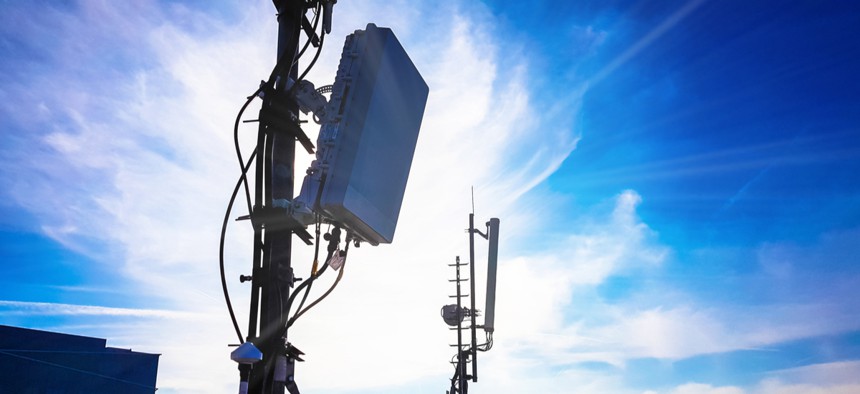After Decision Upholding FCC’s 5G Rules, Cities Now Weighing Appeal

TPROduction/Shutterstock.com
The 9th U.S. Circuit Court of Appeals largely upheld FCC rules limiting local government’s ability to regulate 5G infrastructure and cap fees. Cities involved in the case have until Sept. 28 to file an appeal, but some experts say the ruling wasn’t all bad.
Dozens of cities and counties were on the losing end of a federal court decision last month that largely upheld Federal Communications Commission rules restricting their ability to regulate technology for 5G infrastructure.
Local governments that objected to the rules now have until Sept. 28 to file an appeal for a new hearing before the entire 9th U.S. Circuit Court of Appeals—a step at least some are considering.
“We are speaking with our clients right now about whether or not to do that,” said Gerry Lederer, an attorney with Best, Best and Krieger, who represents the National League of Cities and a coalition of cities and counties in the litigation.
One of the cities considering the appeal is Piedmont, California, where lawmakers are expected to vote Monday on the issue. A staff report sent Friday to the city’s mayor and council by the city administrator recommends officials support the appeal to maintain “local control over wireless facilities in Piedmont.”
Piedmont Mayor Robert McBain has advocated for the city to restore local control over wireless infrastructure, saying “current rules greatly reduce our ability to decide what and where these facilities can be installed.”
An appeal would allow cities and counties another chance to win back regulatory control at a time telecom providers continue to deploy 5G infrastructure across the country.
The coronavirus pandemic, which has resulted in millions working and attending school remotely, has underscored the important role 5G can play in improving internet connection speeds and bandwidth.
5G technology requires the installation of small cell wireless facilities, which are often designed as boxes that can be attached to existing utility poles. But local governments are concerned about the look of the sometimes-clunky devices and would like to be able to charge telecom providers money to attach them to city-owned infrastructure.
Cities and towns have sought to regulate the installation of the small cells, sometimes requiring telecom providers to pay user fees, meet certain aesthetic guidelines, or at times banning their use altogether. In many cities, leaders have said they want to see a 5G rollout, but complained that giving companies access to right-of-ways and reviewing applications can be time consuming and they should be able to recoup the full costs associated with the process.
The FCC felt those local ordinances were impeding the deployment of infrastructure critical to 5G expansion and in 2018 the agency approved an order that capped fees jurisdictions could charge providers and set strict timelines for local government permitting approval. Dozens of cities, counties and government organizations opposed the rule and challenged it in federal court, with many critics saying the $500 per pole limitation to put up a new box was too low in certain jurisdictions.
The 9th Circuit’s ruling largely sided with the FCC. But telecom experts have emphasized that the ruling wasn’t all bad for municipalities and actually upheld some authority and flexibility on local regulations.
While the ruling backs the FCC’s cap on fees that municipalities can charge (envisioned as a limit of up to $500 for application fees and $270 for annual fees), it “allows for a lot more flexibilities than cities think,” said Mark Del Bianco, a communications industry attorney who has advised a consortium of local governments and organizations on the order. Cities could conduct cost assessments for the time spent reviewing small cell applications, he said.
“If someone spends the time to figure out what is involved, and all the resources, they will come up with numbers far higher than that,” he said.
Backed with those assessments, cities would likely be able to justify charging much higher applications fees, Del Bianco said. However, it would be difficult to charge higher annual fees, because presumably less work would be required after an initial installation, he said.
“The 9th Circuit decision suggests cities do have the authority to access fees over and above safe harbor, they just need to justify it as related to costs,” said Angelina Panettieri, the principal associate for technology and communications for the National League of Cities.
The ruling upheld limits on the amount of time cities can take to review permitting and zoning applications for small cell technology, meaning local governments will have to abide by those time frames or risk legal action.
But the ruling tossed out the FCC’s requirement that local governments’ aesthetic regulations be “objective,” finding that “it preempts too broadly.”
“At the very least, the agency must explain the harm that it is addressing, and the extent to which it intends to limit regulations meant to serve traditional zoning objectives of preventing deployments that are unsightly or out of neighborhood character,” the ruling states.
The ruling will enable cities to come up with aesthetic guidelines regarding small cell technology, giving them more control over what the devices look like and how they blend into their communities, Panettieri said. Those guidelines could potentially include undergrounding requirements for utilities, Del Bianco wrote in an analysis of the ruling.
While telecom companies have already struck some deals with cities and begun to deploy 5G technology—San Jose reached an agreement with providers that included much higher fee per pole—others are still in the planning phase. The ruling gives city officials the go ahead to develop their own regulations regarding aesthetics so that when the time comes, their plans can serve as a starting point for negotiations with telecom companies, Panettieri said.
“One of the things that alleviates a lot of angst about small cell siting is if the community can work with providers to establish standards,” Panettieri said.





